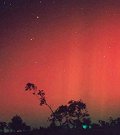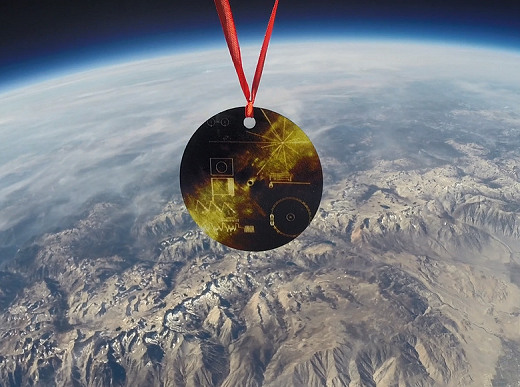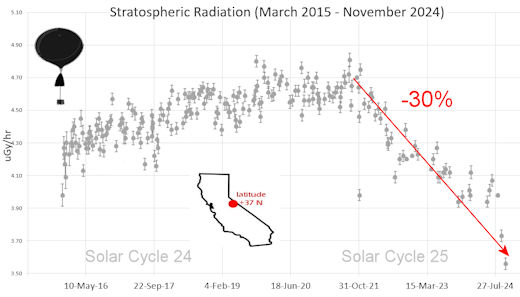 |
| |

SPACE WEATHER
NOAA Forecasts |
|
Updated at: 2025 Oct 28 2200 UTC
FLARE |
0-24
hr |
24-48
hr |
CLASS M |
05
% |
05
% |
CLASS X |
01
% |
01
% |
 Geomagnetic Storms:
Geomagnetic Storms:
Probabilities for significant
disturbances in Earth's magnetic field are given for three activity levels: active, minor
storm, severe
storm
Updated at: 2025 Oct 28 2200 UTC
Mid-latitudes
|
0-24
hr |
24-48
hr |
ACTIVE |
40
% |
40
% |
MINOR |
30
% |
20
% |
SEVERE |
15
% |
05
% |
High latitudes
|
0-24
hr |
24-48
hr |
ACTIVE |
05
% |
10
% |
MINOR |
25
% |
25
% |
SEVERE |
70
% |
60
% |
|
|
|
 |
|
|
|
| |
|
|
|
| |
This is an AI Free Zone: Text created by Large Language Models is spreading across the Internet. It's well-written, but frequently inaccurate. If you find a mistake on Spaceweather.com, rest assured it was made by a real human being.
|
|
|
IS COMET 3I/ATLAS REALLY A SPACESHIP? We’re about to find out. On Oct. 29th, the interstellar object will make its closest approach to the sun. Perihelion is the perfect time to perform a Solar Oberth maneuver or to deploy stealthy probes. If we see any unexpected non-gravitational acceleration, artificial lights, or excess heat (engine activity), it could point to alien tech. Otherwise, 3I/ATLAS is what it appears to be--a comet. Contrary to widespread reports, we can see 3I/ATLAS from Earth, so this will be a legitimate "acid test" of the spaceship hypothesis.
Feedback on the Comet 3I/ATLAS story: We have received an unusual number of strongly-worded emails about our coverage of Comet 3I/ATLAS. About half look like this:

Almost as many say, "It's a spaceship. Stop trying to cover it up!"
For the record, we think 3I/ATLAS is an exotic comet. But, like it or not, Harvard astronomer Avi Loeb's attention-seeking spacecraft hypothesis is testable. An Oberth maneuver at perihelion would change our minds about this interstellar object. "Pushing garbage" or the scientific method? You decide.
THE HALLOWEEN STORMS: Exactly 22 years ago today, one of the most powerful CMEs of the Space Age struck Earth's magnetic field. The impact kickstarted the Halloween Storms. Here's what Spaceweather.com had to say on Oct. 29, 2003:
"An extreme geomagnetic storm is in progress following the arrival of a CME at approximately 0630 UT. In the United States, auroras (gallery) have appeared as far south as Georgia, California, New Mexico, Arizona, Texas, and Oklahoma.
 Right: Not far from Houston, Texas, photographer Christie Ponder snapped this picture of red auroras. "What a wonderful show! Vivid spikes shot up about 15 to 20 degrees above the horizon," she says. Right: Not far from Houston, Texas, photographer Christie Ponder snapped this picture of red auroras. "What a wonderful show! Vivid spikes shot up about 15 to 20 degrees above the horizon," she says.
The prospects for more auroras tonight are good, mainly because the interplanetary magnetic field (IMF) near Earth has tilted sharply south--a condition that promotes geomagnetic activity. Sky watchers at all latitudes should be alert for auroras after local nightfall.
Meanwhile, another powerful solar flare (X11-class) has erupted from giant sunspot 486. Stay tuned for details."
Unknown to forecasters at the time, active sunspot 486 would unleash even stronger solar flares in the days ahead, sparking a truly historic storm. Come back tomorrow to see what happened next.
Realtime Space Weather Photo Gallery
Free: Spaceweather.com Newsletter
VOYAGER GOLDEN RECORD: This is a must-have Christmas ornament for space fans: The Voyager Golden Record. On Oct. 31, 2023, the students of Earth to Sky Calculus launched it to the stratosphere onboard a cosmic ray research balloon:

You can have it for $99.95. The 3-inch aluminum disk is imprinted with instructions for extraterrestrials, telling ET how to play the sounds of Earth. The original phonograph records are sailing through interstellar space onboard NASA's Voyager probes. Having touched the edge of space, this is the closest thing on Earth to an actual Golden Record. The ornament comes with extra materials decoding the markings on the disk.
The students are selling space ornaments to support their cosmic ray ballooning program. Each one comes with a greeting card showing the ornament in flight and telling the story of its journey to the edge of space.
Far Out Gifts: Earth to Sky Store
All sales support hands-on STEM education
Realtime Aurora Photo Gallery
Free: Spaceweather.com Newsletter
Every night, a network
of NASA
all-sky cameras scans the skies above the United
States for meteoritic fireballs. Automated software
maintained by NASA's Meteoroid Environment Office
calculates their orbits, velocity, penetration depth
in Earth's atmosphere and many other characteristics.
Daily results are presented here on Spaceweather.com.
On Oct 29, 2025, the network reported 18 fireballs.
(10 sporadics, 5 Southern Taurids, 3 Orionids)

In this diagram of the inner solar system, all of the fireball orbits intersect at a single point--Earth. The orbits are color-coded by velocity, from slow (red) to fast (blue).
[Larger image] [movies]
Potentially Hazardous Asteroids ( PHAs)
are space rocks larger than approximately 100m that
can come closer to Earth than 0.05 AU. None of the
known PHAs is on a collision course with our planet,
although astronomers are finding new
ones all the time.
On October 29, 2025 there were 2349 potentially hazardous asteroids.
 |
Recent
& Upcoming Earth-asteroid encounters:
| Asteroid |
Date(UT) |
Miss Distance |
Velocity (km/s) |
Diameter (m) |
| 2025 UL1 |
2025-Oct-24 |
9.1 LD |
14.1 |
30 |
| 2025 UE7 |
2025-Oct-24 |
2.4 LD |
6.6 |
8 |
| 2025 UT6 |
2025-Oct-24 |
3 LD |
15 |
39 |
| 2025 UY7 |
2025-Oct-24 |
7.3 LD |
13.1 |
13 |
| 2025 UT5 |
2025-Oct-24 |
1.6 LD |
2.9 |
15 |
| 2025 TX2 |
2025-Oct-24 |
6.4 LD |
6.8 |
26 |
| 2025 UG4 |
2025-Oct-25 |
16.4 LD |
25.8 |
40 |
| 2012 TP231 |
2025-Oct-25 |
15.2 LD |
6.7 |
37 |
| 2025 UX1 |
2025-Oct-25 |
3.6 LD |
14.4 |
10 |
| 2025 UW5 |
2025-Oct-25 |
1.5 LD |
14.2 |
11 |
| 2025 UP2 |
2025-Oct-25 |
5.2 LD |
3.1 |
6 |
| 2025 US5 |
2025-Oct-25 |
0.6 LD |
10.2 |
3 |
| 2025 UD3 |
2025-Oct-25 |
1.9 LD |
6.3 |
7 |
| 2025 UU |
2025-Oct-25 |
5 LD |
12.6 |
26 |
| 2025 UJ5 |
2025-Oct-25 |
4.7 LD |
3.3 |
9 |
| 2025 UN8 |
2025-Oct-25 |
4.3 LD |
8.7 |
7 |
| 2025 UV6 |
2025-Oct-25 |
0.5 LD |
26.7 |
8 |
| 2025 UE8 |
2025-Oct-26 |
3.9 LD |
9.8 |
13 |
| 2025 UU1 |
2025-Oct-26 |
16.2 LD |
13.3 |
28 |
| 2025 UV2 |
2025-Oct-26 |
14.6 LD |
7.7 |
12 |
| 2025 UM7 |
2025-Oct-26 |
4 LD |
14.8 |
13 |
| 2009 HC |
2025-Oct-26 |
8.6 LD |
4.2 |
39 |
| 2025 UU7 |
2025-Oct-26 |
6.6 LD |
17.5 |
24 |
| 2025 UJ2 |
2025-Oct-26 |
18.9 LD |
14.5 |
50 |
| 2025 UE6 |
2025-Oct-26 |
16.6 LD |
10.7 |
28 |
| 2025 UZ7 |
2025-Oct-27 |
0.3 LD |
8.7 |
4 |
| 2025 UF3 |
2025-Oct-27 |
6.2 LD |
3.2 |
13 |
| 2025 UH6 |
2025-Oct-27 |
2.4 LD |
8.5 |
12 |
| 2025 UK7 |
2025-Oct-27 |
18.2 LD |
12.5 |
17 |
| 434196 |
2025-Oct-27 |
17.4 LD |
10.9 |
171 |
| 2025 UM8 |
2025-Oct-28 |
7.3 LD |
14.8 |
36 |
| 2025 UC8 |
2025-Oct-28 |
1.3 LD |
8.1 |
10 |
| 2025 UD7 |
2025-Oct-28 |
5.8 LD |
8.6 |
12 |
| 2025 UQ1 |
2025-Oct-28 |
10.4 LD |
5.8 |
10 |
| 2025 UV7 |
2025-Oct-29 |
0.3 LD |
9.6 |
4 |
| 2025 UD5 |
2025-Oct-29 |
2.5 LD |
3.2 |
20 |
| 2025 UH2 |
2025-Oct-29 |
19.3 LD |
8.9 |
29 |
| 2025 UV5 |
2025-Oct-29 |
4.3 LD |
5.6 |
18 |
| 2025 UF5 |
2025-Oct-29 |
2 LD |
3 |
10 |
| 2025 UX7 |
2025-Oct-29 |
0.9 LD |
20 |
7 |
| 2025 UP7 |
2025-Oct-29 |
4 LD |
13.8 |
13 |
| 2025 UL2 |
2025-Oct-29 |
3.9 LD |
12.4 |
22 |
| 2025 UF4 |
2025-Oct-30 |
15.3 LD |
10.2 |
75 |
| 2025 UH7 |
2025-Oct-31 |
2.2 LD |
7.8 |
8 |
| 2025 UO7 |
2025-Nov-01 |
8 LD |
7.6 |
17 |
| 2025 TP11 |
2025-Nov-02 |
12 LD |
8.4 |
35 |
| 2005 EZ223 |
2025-Nov-03 |
15.6 LD |
12.9 |
118 |
| 2023 VK6 |
2025-Nov-03 |
7.6 LD |
9.6 |
15 |
| 2025 TB12 |
2025-Nov-04 |
7.3 LD |
6.3 |
19 |
| 2025 UO8 |
2025-Nov-06 |
17.9 LD |
7.2 |
33 |
| 2025 UL4 |
2025-Nov-07 |
16.9 LD |
8.3 |
25 |
| 2021 VQ10 |
2025-Nov-08 |
9 LD |
15 |
13 |
| 2019 UH7 |
2025-Nov-08 |
13.3 LD |
5.8 |
11 |
| 2018 KC |
2025-Nov-09 |
16 LD |
9.3 |
11 |
| 2017 WG14 |
2025-Nov-09 |
16.7 LD |
11.7 |
45 |
| 2020 VK4 |
2025-Nov-10 |
16.4 LD |
3.8 |
9 |
| 2012 VC26 |
2025-Nov-11 |
13.3 LD |
6.4 |
6 |
| 2019 VL5 |
2025-Nov-14 |
14.7 LD |
9.1 |
24 |
| 2022 FG4 |
2025-Nov-17 |
18.7 LD |
22.2 |
105 |
| 3361 |
2025-Nov-19 |
14.8 LD |
9.1 |
435 |
| 2013 NJ4 |
2025-Nov-20 |
12.6 LD |
6.4 |
12 |
| 2021 WR |
2025-Nov-22 |
19.3 LD |
10 |
31 |
| 516155 |
2025-Nov-24 |
12.5 LD |
16.7 |
338 |
| 2020 WM |
2025-Nov-24 |
17.4 LD |
11.8 |
36 |
| 2019 UT6 |
2025-Nov-25 |
6.2 LD |
12.6 |
147 |
| 2018 WG2 |
2025-Nov-27 |
13.5 LD |
7.5 |
3 |
| 2007 VM184 |
2025-Dec-01 |
13.1 LD |
20 |
224 |
| 2018 WC2 |
2025-Dec-03 |
9.8 LD |
8.9 |
36 |
| 2021 JE1 |
2025-Dec-08 |
13.5 LD |
7.1 |
16 |
| 2019 XN3 |
2025-Dec-10 |
5.7 LD |
3.6 |
15 |
| 1999 SF10 |
2025-Dec-10 |
8.2 LD |
4.4 |
46 |
| 2016 YH |
2025-Dec-13 |
6.8 LD |
8.9 |
28 |
| 2025 TZ |
2025-Dec-15 |
17.8 LD |
6.2 |
52 |
| 2015 XX168 |
2025-Dec-18 |
4.7 LD |
11.6 |
27 |
| 2010 WR7 |
2025-Dec-20 |
19.5 LD |
8.3 |
71 |
Notes: LD means
"Lunar Distance." 1 LD = 384,401 km, the distance
between Earth and the Moon. 1 LD also equals 0.00256
AU.
| |
Cosmic Rays in the Atmosphere |
SPACE WEATHER BALLOON DATA: Almost once a week, Spaceweather.com and the students of Earth to Sky Calculus fly space weather balloons to the stratosphere over California. These balloons are equipped with sensors that detect secondary cosmic rays, a form of radiation from space that can penetrate all the way down to Earth's surface. Our monitoring program has been underway without interruption for 10 years, resulting in a unique dataset of in situ atmospheric measurements.
Latest results (Nov. 2024): Atmospheric radiation is sharply decreasing in 2024. Our latest measurements in November registered a 10-year low:

What's going on? Ironically, the radiation drop is caused by increasing solar activity. Solar Cycle 25 has roared to life faster than forecasters expected. The sun's strengthening and increasingly tangled magnetic field repels cosmic rays from deep space. In addition, solar coronal mass ejections (CMEs) sweep aside cosmic rays, causing sharp reductions called "Forbush Decreases." The two effects blend together to bring daily radiation levels down.
.Who cares? Cosmic rays are a surprisingly "down to Earth" form of space weather. They can alter the chemistry of the atmosphere, trigger lightning, and penetrate commercial airplanes. According to a study from the Harvard T.H. Chan school of public health, crews of aircraft have higher rates of cancer than the general population. The researchers listed cosmic rays, irregular sleep habits, and chemical contaminants as leading risk factors. A number of controversial studies (#1, #2, #3, #4) go even further, linking cosmic rays with cardiac arrhythmias and sudden cardiac death.
Technical notes: The radiation sensors onboard our helium balloons detect X-rays and gamma-rays in the energy range 10 keV to 20 MeV. These energies span the range of medical X-ray machines and airport security scanners.
Data points in the graph labeled "Stratospheric Radiation" correspond to the peak of the Regener-Pfotzer maximum, which lies about 67,000 feet above central California. When cosmic rays crash into Earth's atmosphere, they produce a spray of secondary particles that is most intense at the entrance to the stratosphere. Physicists Eric Regener and Georg Pfotzer discovered the maximum using balloons in the 1930s and it is what we are measuring today.
| |
The
official U.S. government space weather bureau |
| |
The
first place to look for information about sundogs,
pillars, rainbows and related phenomena. |
| |
Researchers
call it a "Hubble for the sun." SDO
is the most advanced solar observatory ever. |
| |
3D
views of the sun from NASA's Solar and Terrestrial
Relations Observatory |
| |
Realtime
and archival images of the Sun from SOHO. |
| |
information about sunspots based on the latest NOAA/USAF Active Region Summary |
| |
current counts of failed and deployed Starlink satellites from Jonathan's Space Page. See also, all satellite statistics. |
| |
Authoritative predictions of space junk and satellite re-entries |
| |
from
the NOAA Space Environment Center |
| |
fun to read, but should be taken with a grain of salt! Forecasts looking ahead more than a few days are often wrong. |
| |
from the NOAA Space Environment Center |
| |
the
underlying science of space weather |
 |
Got a chipped or cracked windshield that prevents you from seeing space weather events while driving? Get windshield replacement from SR Windows & Glass with free mobile auto glass service anywhere in the Phoenix area. |
| |
These links help Spaceweather.com stay online. Thank you to our supporters! |
|
|
| |
|
|
|
|
 |
|
 |

 |
©2021 Spaceweather.com. All rights reserved. This site is penned daily by Dr. Tony Phillips. |